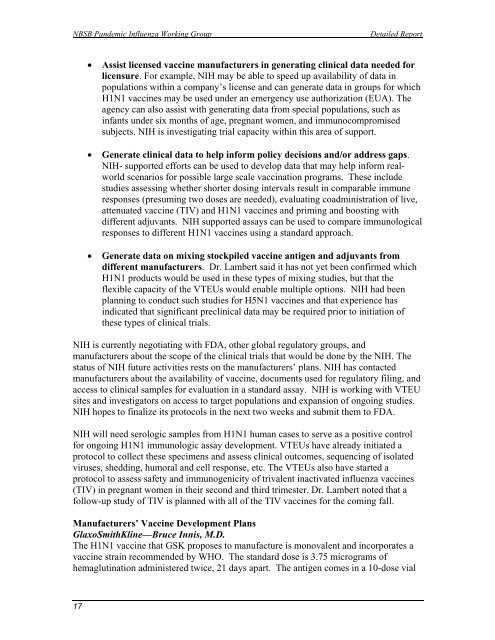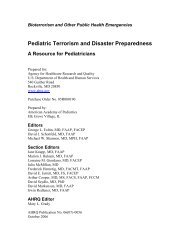H1N1 COUNTERMEASURES STRATEGY AND ... - PHE Home
H1N1 COUNTERMEASURES STRATEGY AND ... - PHE Home
H1N1 COUNTERMEASURES STRATEGY AND ... - PHE Home
You also want an ePaper? Increase the reach of your titles
YUMPU automatically turns print PDFs into web optimized ePapers that Google loves.
NBSB Pandemic Influenza Working Group<br />
Detailed Report<br />
<br />
<br />
<br />
Assist licensed vaccine manufacturers in generating clinical data needed for<br />
licensure. For example, NIH may be able to speed up availability of data in<br />
populations within a company’s license and can generate data in groups for which<br />
<strong>H1N1</strong> vaccines may be used under an emergency use authorization (EUA). The<br />
agency can also assist with generating data from special populations, such as<br />
infants under six months of age, pregnant women, and immunocompromised<br />
subjects. NIH is investigating trial capacity within this area of support.<br />
Generate clinical data to help inform policy decisions and/or address gaps.<br />
NIH- supported efforts can be used to develop data that may help inform realworld<br />
scenarios for possible large scale vaccination programs. These include<br />
studies assessing whether shorter dosing intervals result in comparable immune<br />
responses (presuming two doses are needed), evaluating coadministration of live,<br />
attenuated vaccine (TIV) and <strong>H1N1</strong> vaccines and priming and boosting with<br />
different adjuvants. NIH supported assays can be used to compare immunological<br />
responses to different <strong>H1N1</strong> vaccines using a standard approach.<br />
Generate data on mixing stockpiled vaccine antigen and adjuvants from<br />
different manufacturers. Dr. Lambert said it has not yet been confirmed which<br />
<strong>H1N1</strong> products would be used in these types of mixing studies, but that the<br />
flexible capacity of the VTEUs would enable multiple options. NIH had been<br />
planning to conduct such studies for H5N1 vaccines and that experience has<br />
indicated that significant preclinical data may be required prior to initiation of<br />
these types of clinical trials.<br />
NIH is currently negotiating with FDA, other global regulatory groups, and<br />
manufacturers about the scope of the clinical trials that would be done by the NIH. The<br />
status of NIH future activities rests on the manufacturers’ plans. NIH has contacted<br />
manufacturers about the availability of vaccine, documents used for regulatory filing, and<br />
access to clinical samples for evaluation in a standard assay. NIH is working with VTEU<br />
sites and investigators on access to target populations and expansion of ongoing studies.<br />
NIH hopes to finalize its protocols in the next two weeks and submit them to FDA.<br />
NIH will need serologic samples from <strong>H1N1</strong> human cases to serve as a positive control<br />
for ongoing <strong>H1N1</strong> immunologic assay development. VTEUs have already initiated a<br />
protocol to collect these specimens and assess clinical outcomes, sequencing of isolated<br />
viruses, shedding, humoral and cell response, etc. The VTEUs also have started a<br />
protocol to assess safety and immunogenicity of trivalent inactivated influenza vaccines<br />
(TIV) in pregnant women in their second and third trimester. Dr. Lambert noted that a<br />
follow-up study of TIV is planned with all of the TIV vaccines for the coming fall.<br />
Manufacturers’ Vaccine Development Plans<br />
GlaxoSmithKline—Bruce Innis, M.D.<br />
The <strong>H1N1</strong> vaccine that GSK proposes to manufacture is monovalent and incorporates a<br />
vaccine strain recommended by WHO. The standard dose is 3.75 micrograms of<br />
hemaglutination administered twice, 21 days apart. The antigen comes in a 10-dose vial<br />
17
















